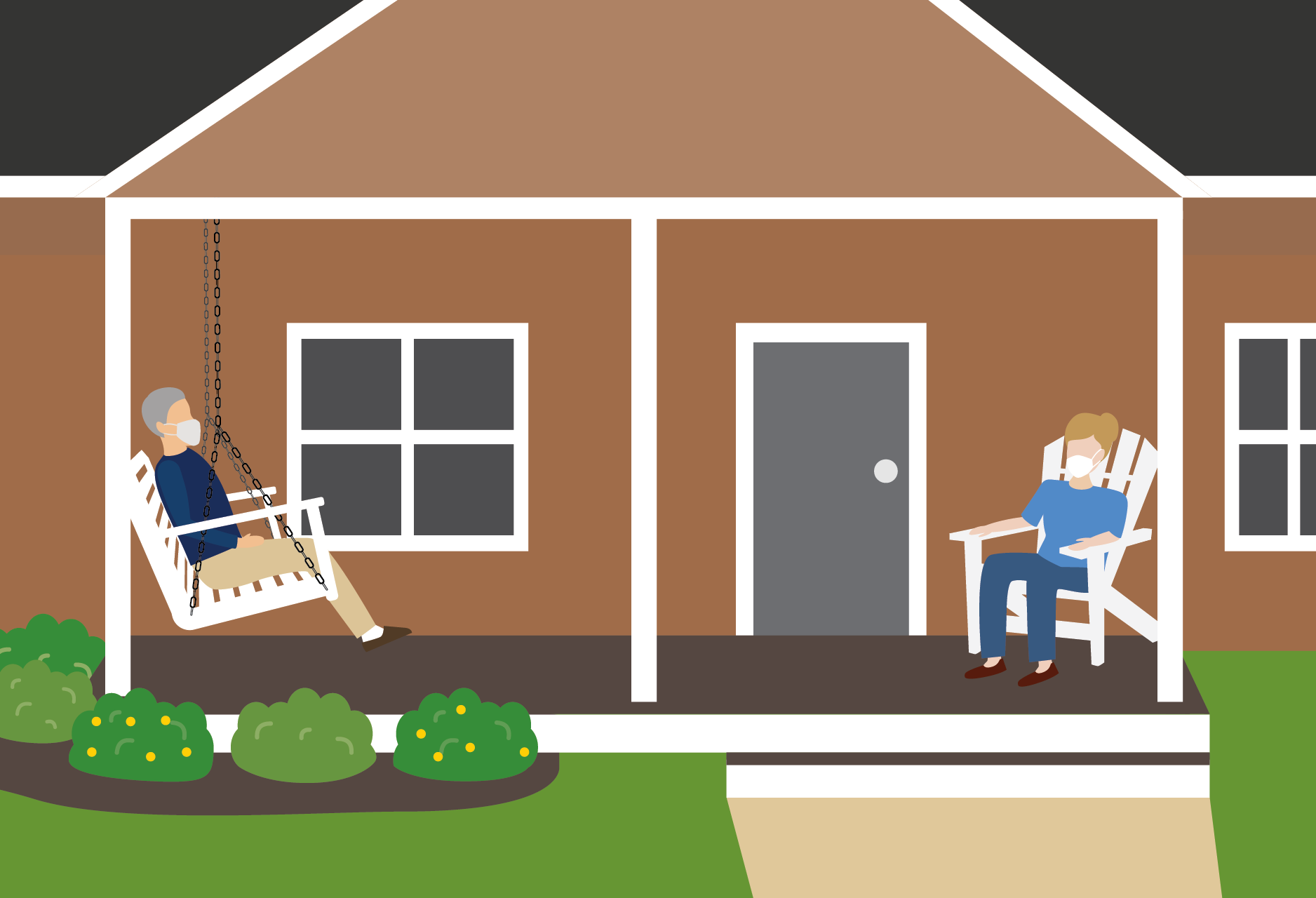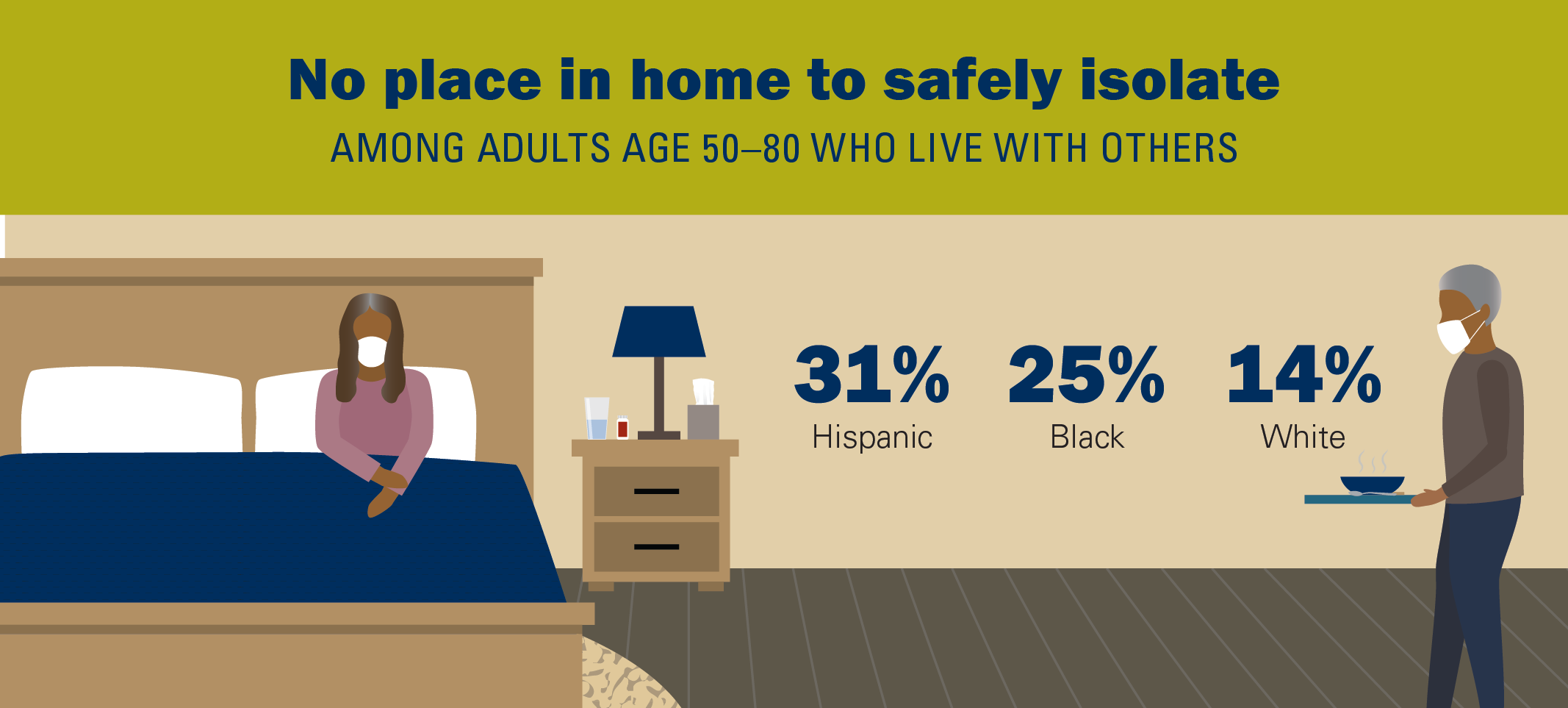
Recommendations to slow the spread of COVID-19 include staying home when possible, isolating from others if symptoms develop, and getting outdoors to safely connect with other people and exercise. Yet where a person lives—including their home and neighborhood—can influence their ability to follow these recommendations. In June 2020, the National Poll on Healthy Aging asked a national sample of adults age 50–80 about their living environments and behaviors during the pandemic.
A place to safely isolate
Nearly one in five older adults who live with others (18%) reported they do not have a place where they live to safely isolate if they were to contract COVID-19. Older adults who were less likely to have a place to safely isolate included Hispanics and Blacks compared with Whites (31% and 25% respectively vs. 14%), those with an annual household income less than $30,000 compared with more than $100,000 (31% vs. 13%), those living in an apartment compared with a detached single-family home (35% vs. 15%), and those in fair or poor physical health compared with those in excellent, very good, or good health (27% vs. 17%).

Access to outdoor spaces
Most adults age 50–80 (85%) reported having an outdoor space (such as a balcony, patio, porch, or yard) to safely engage with their neighbors and community during the pandemic. Three in four older adults (72%) said they have a view of nature from inside their home. Two in three (68%) noted they have a greenspace (such as a garden, park, or woods) within walking distance of their home.
Having an outdoor space to safely engage with neighbors, a view of nature from inside the home, or a greenspace within walking distance were all less common among older adults with an annual household income less than $30,000, Hispanics and Blacks, those who live in an apartment, and those in fair or poor health. For example, access to a greenspace within walking distance was reported by 73% of Whites compared with 54% of Blacks and 50% of Hispanics, and by 78% of those with an annual income of $100,000 or more compared with 49% of those with an annual household income less than $30,000.
From March through June 2020, three in four adults age 50–80 (75%) said they spent time outdoors or interacted with nature at least a few times a week. Nearly half of older adults interacted with people in their neighborhood outdoors (46%) or walked or biked around their neighborhood at least a few times a week (45%). Older adults who had access to an outdoor space to engage with their neighbors and community, a view of nature, or nearby greenspaces were more likely to engage in outdoor activities. In addition, older adults who did not have access to outdoor spaces, a view of nature, or nearby greenspaces were more likely to report feelings of loneliness, including a lack of companionship and feeling isolated from others, than those who had access to these features in their environment.
Implications
The characteristics of homes and neighborhoods can affect an individual’s ability to carry out public health recommendations to reduce the spread of COVID-19 and may contribute to disparities in rates of infection.
Nearly one in five older adults who live with others do not have a place where they live to safely isolate if they were to contract COVID-19 with notable disparities by race and ethnicity, income, dwelling type, and health status. In addition, older adults from these same groups are less likely to have access to outdoor spaces to engage with neighbors, views of nature, and nearby greenspaces, all of which are related to health-promoting activities. Health care providers and health officials should provide recommendations to help reduce risk to others as much as possible while taking various living situations and circumstances into account.
Previous research and these poll results suggest that a person’s home and neighborhood can potentially affect their community engagement, physical activity, and feelings of loneliness. This is especially true during the pandemic when older adults and other vulnerable individuals have been encouraged to stay home as much as possible. Given the connection between environment and engagement in health-promoting activities, policymakers, architects, and urban planners should work to create equitable access to environmental features that can support well-being and resilience during and after the pandemic.
Data Source and Methods
This National Poll on Healthy Aging report presents findings from a nationally representative household survey conducted exclusively by Ipsos Public Affairs, LLC (“Ipsos”) for the University of Michigan’s Institute for Healthcare Policy and Innovation. National Poll on Healthy Aging surveys are conducted by recruiting from Ipsos KnowledgePanel®, the largest national, probability-based panel in the U.S.
This survey module was administered online in June 2020 to a randomly selected, stratified group of older adults age 50–80 (n=2,074). The sample was subsequently weighted to reflect population figures from the U.S. Census Bureau.
The completion rate was 78% among panel members contacted to participate. The margin of error is ±1 to 2 percentage points for questions asked of the full sample and higher among subgroups. Findings from the National Poll on Healthy Aging do not represent the opinions of the University of Michigan. The University of Michigan reserves all rights over this material.
Read other National Poll on Healthy Aging reports and about the poll's Michigan findings, and learn about the poll methodology.
Citation
Nanda U, Solway E, Ibrahim A, Singer D, Kirch M, Kullgren J, Malani P. At Home and in the Neighborhood During the COVID-19 Pandemic. University of Michigan National Poll on Healthy Aging. January/February 2021. Available at: http://hdl.handle.net/2027.42/166095
Disclosure
In addition to their University of Michigan faculty roles, Upali Nanda has a role with HKS, Inc., and Andrew Ibrahim has a role with HOK, both global architecture firms.
Kimia Erfani, MSc, MArch, doctoral student in architecture in the U-M Taubman College, also contributed to this report.